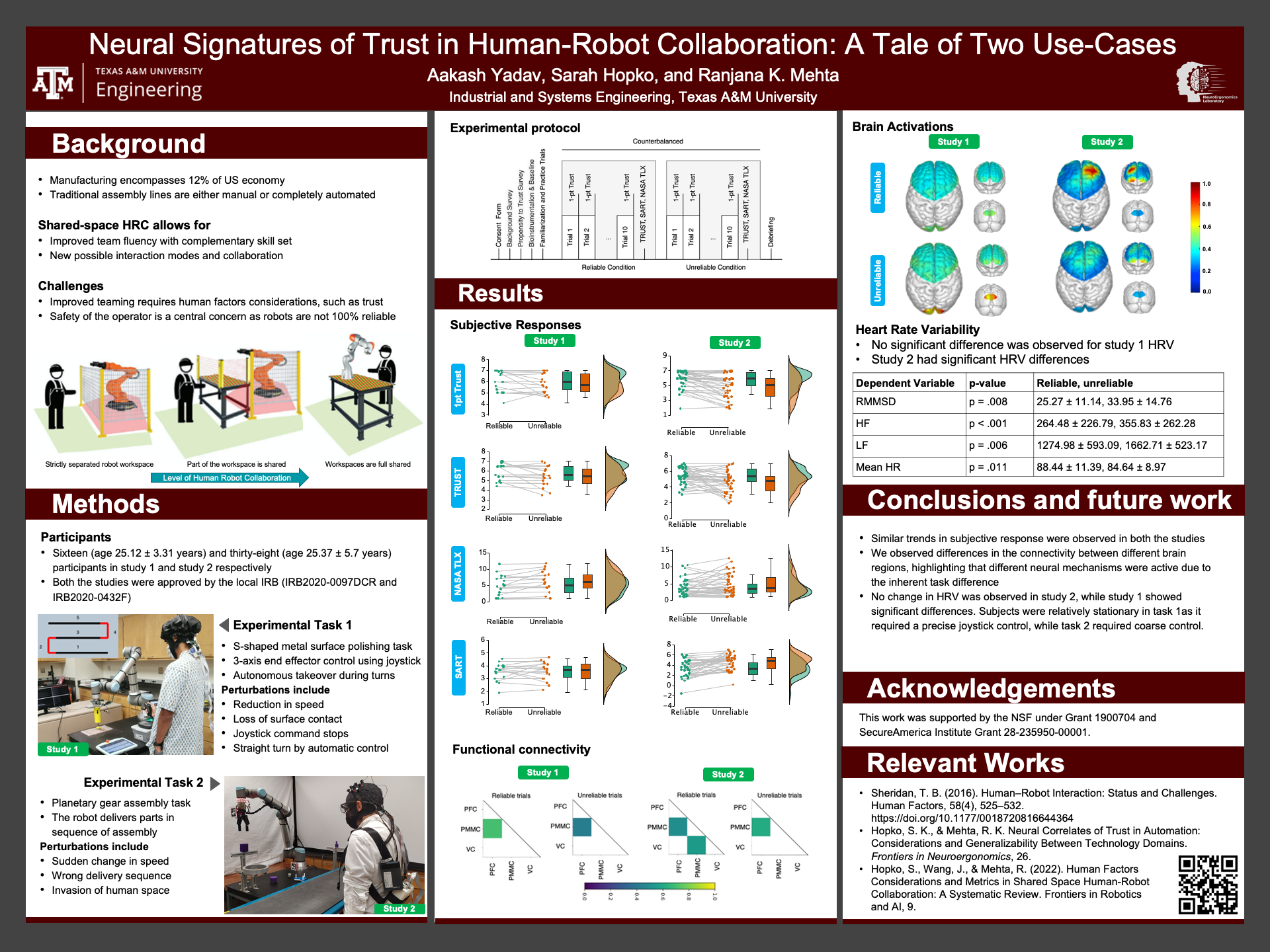The NeuroErgonomics Lab is dedicated to sharing our research accessibly and inclusively. As Human Factors researchers, we are passionate about building a smarter, safer, and technology-enabled workforce that is poised and scaled to transform the future of work across many critical industries. By granting greater access to the tools and insights of modern science, we are able to foster a community that is committed to innovative and scientifically grounded approaches.
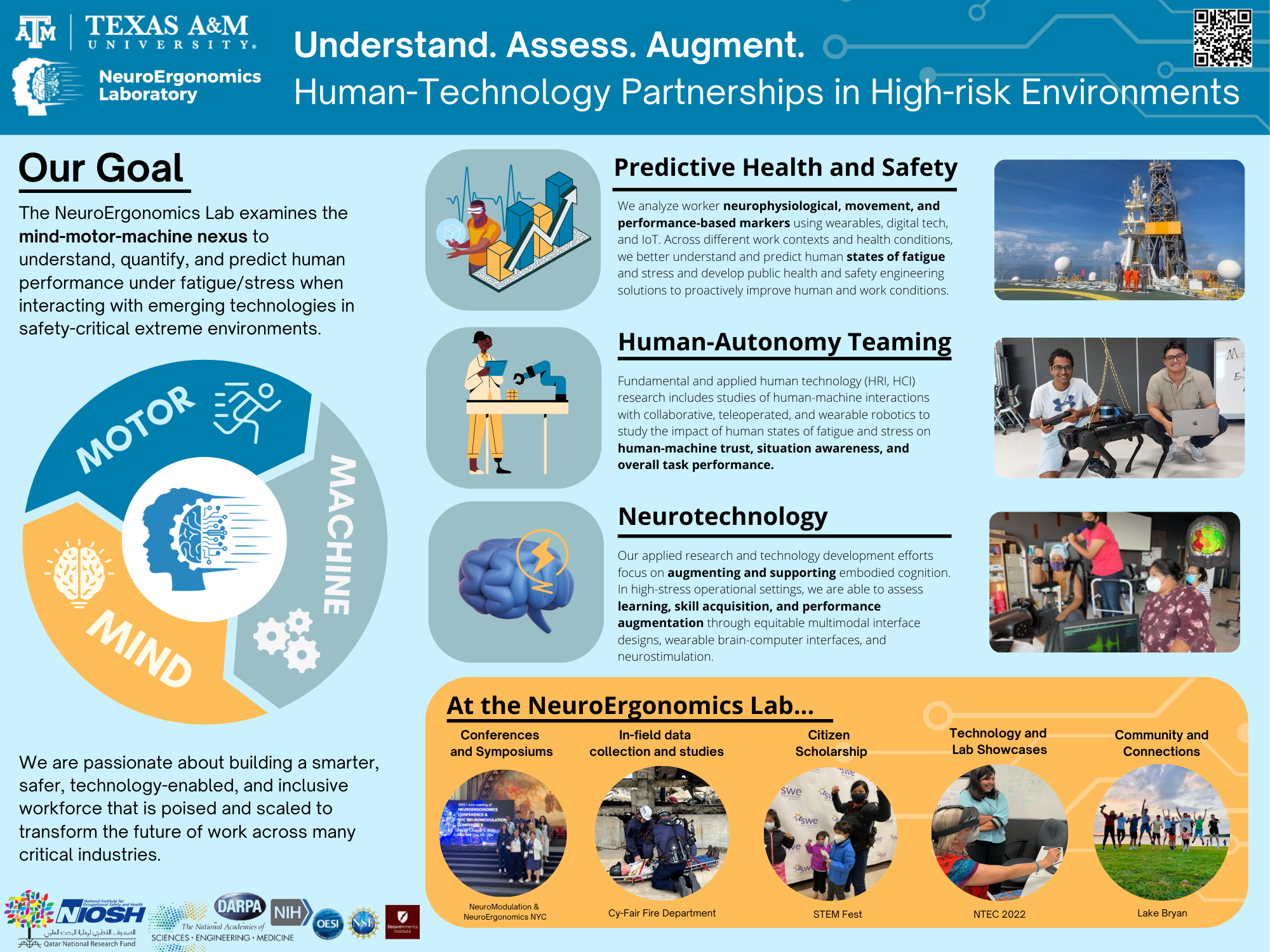
Expand the menus below to learn more about our active projects and research in our lab.
"Fatigue Assessment Methods on Offshore Oil Rigs: Feasibility and Compliance"
Workers’ safety and health have been negatively impacted by fatigue as fatigue has been linked to workplace accidents, fatalities, and injuries in the offshore oil and gas extraction (OGE) industry. Fatigue has been cited as a contributing factor in many disasters, including the Exxon Valdez oil spill and the Texas City refinery explosion. The OGE industry hasn’t implemented various fatigue assessment methods that have been developed by researchers for lab settings to capture and measure fatigue. Furthermore, there are no standard fatigue assessment methods in place for offshore oil rigs.
The objective of this study is to assess the feasibility and compliance rate of various fatigue assessment methods that can be used in real-world offshore environments. A total of 70 offshore workers were followed for 28 days on two different drillships to measure their levels of fatigue daily. A wearable device (Actiheart) was used to measure workers’ Heart Rate Variability before and after every 12-hour shift. They completed multiple subjective questionnaires (Sleepiness Scale, Borg’s Rating of Perceived Exertion, Mental Fatigue) and a 10-minute Psychomotor Vigilance Test (PVT) after every 12-hour shift. The participants wore actigraphy watches while sleeping and kept sleep journals to record their sleep details. For the first two weeks, researchers were stationed in drillships to collect fatigue measures; however, for the last two weeks, workers were instructed to perform the fatigue assessment methods on their own except for heart rate variability.
After the study, the researchers interviewed 31 participants to find out what they thought of various fatigue assessment methods. The compliance rates for fatigue assessment methods were slightly higher in the first two weeks than in the last two weeks, but they remained over 80%. Based on the interviews, it was clear that workers had generally positive experiences and there were few barriers, but the general consensus was that PVT was too long, boring, and mentally demanding. Our analysis of the collected data and interviews will enable us to determine which fatigue assessment methods are feasible in work settings with a high compliance rate. The future works include testing the sensitivity of the shorter-duration PVT as well as developing a visual dashboard for effective decision making.
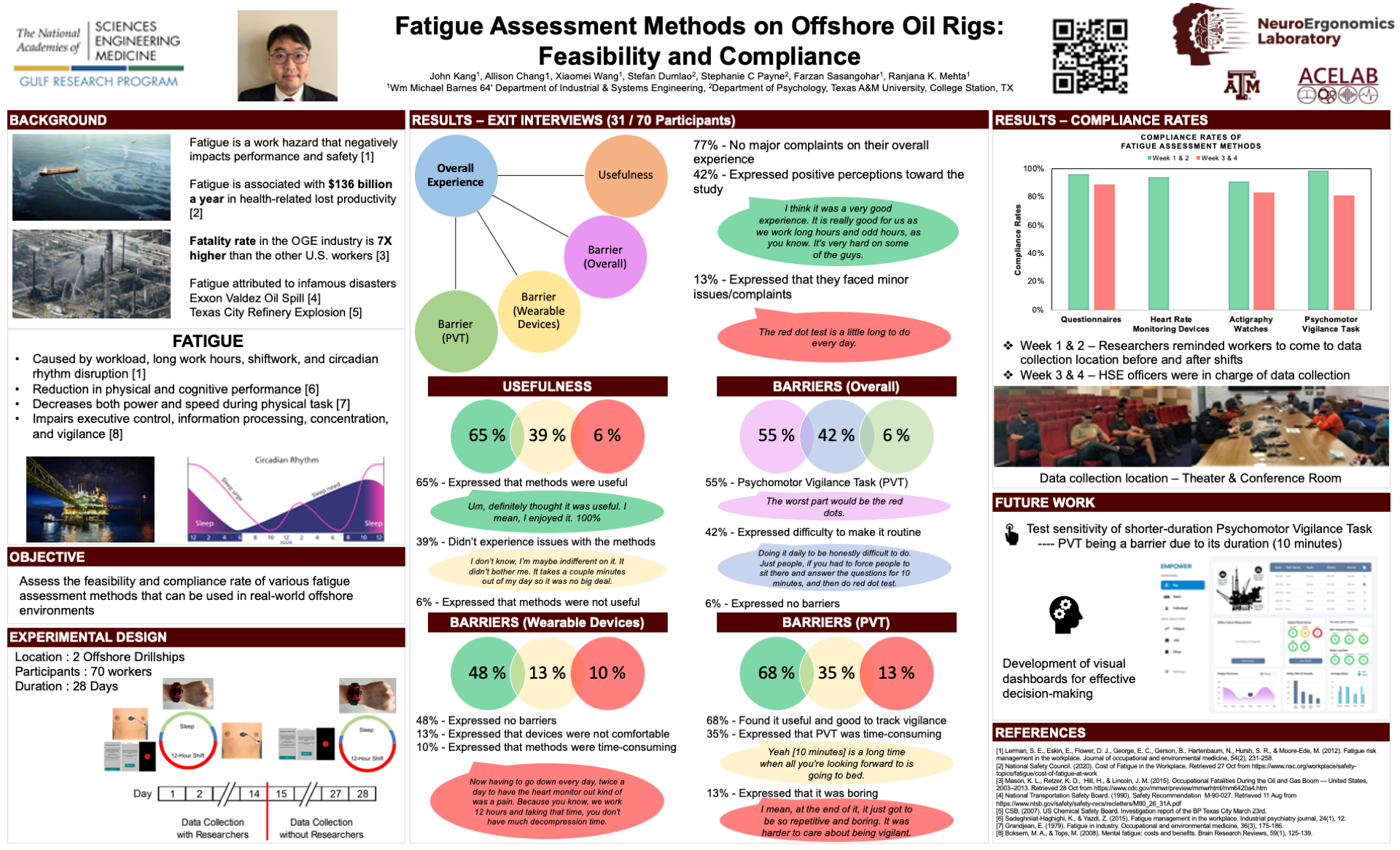
“Analysis of Cognitive Personalized Emergency Medical Training Using Augmented Reality.”
The U.S. Emergency Medical Services (EMS) has faced an acute nationwide shortage of providers over the years. This shortage has reached a crisis level due to the ongoing COVID-19 pandemic as training programs shut down and the call volume has increased, leading to a pressing need to accelerate the training of EMS workers while maintaining a high quality of instruction. Current methods of training use high fidelity manikins and simulation command centers to provide trainees with hands-on practice; however, their limitations include a lack of time and cost efficiency as well as diversity in patients and cases. New approaches have begun exploring the use of human augmentation technologies such as powered exoskeletons, virtual reality, and augmented reality (AR).
The objective of this research is to determine the efficacy of AR as a training delivery modality and to identify the characteristics of first-time users who displayed high and low performance during AR-based training. In our study, 51 participants took part in a 1.5 to 2-hour session in which they completed both a familiarization task (tutorial that trained users on basic AR interactions) and a triage evaluation task that utilized the team’s custom-built virtual triage tag. Participants were placed into one of two groups:
- Group 1 (n = 22) completed an AR-based familiarization followed by the AR triage evaluation task
- Group 2 (n = 23) completed a video-based familiarization task with the same AR-based triage evaluation task.
Subjective survey responses, electrodermal activity, heart rate variability, and performance data gathered throughout the study were analyzed to document user experiences and training effectiveness. Preliminary results indicate that AR-based training affords higher user engagement, better immersion, and greater extraneous load compared to video-based training across both genders. However, AR resulted in a lower physiological load and performance was comparable to video-based training. This data provides insights into how trainees engage and learn in different training modalities and would be used for the development of a novel adaptation model that utilizes machine learning to create a personalized AR-based training protocol.
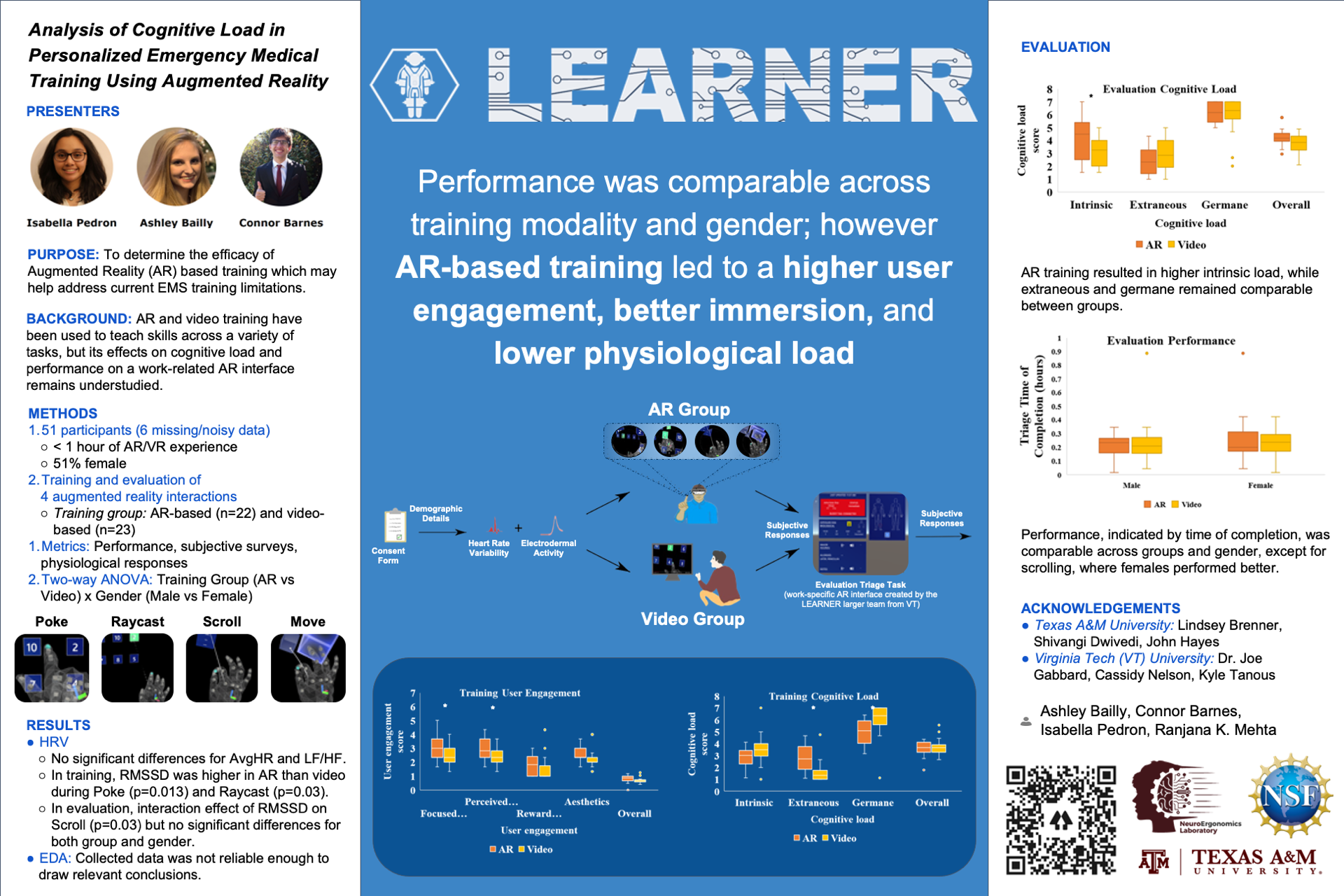
"Central Mechanisms during Fatiguing Exercises under the influence of Cognitive Stress"
High-stress and physically demanding environments that workers in occupations such as oil and gas and emergency response experience can influence their physical performance and capacity. This is a critical concern among the rapidly aging workforce . A better understanding of the influence of stress on neuromuscular fatigue and its determinants is necessary. Cognitive stress can accelerate neuromuscular fatigue via impairments in the prefrontal cortex (PFC) activation .
The PFC potentially affects peripheral muscle activity by integrating psychological factors, such as motivation and emotions, with feedback from the muscle. Using Transcranial Magnetic Stimulation (TMS) during voluntary exercise, studies have shown the critical role M1 plays in exercise regulation. For example, by stimulating the M1 using TMS, one can determine the degree to which central fatigue impacts downstream motor performance. However, whether altered PFC activity under stress impacts central fatigue is currently unknown. Therefore, our study aims to determine the impact of cognitive stress on neuromuscular fatigue in older adults through a neuroergonomics approach by assessing the relationship between PFC and M1 using TMS and brain imaging. Preliminary results show that the influence of stress on the central mechanisms of fatigue is sex-specific.
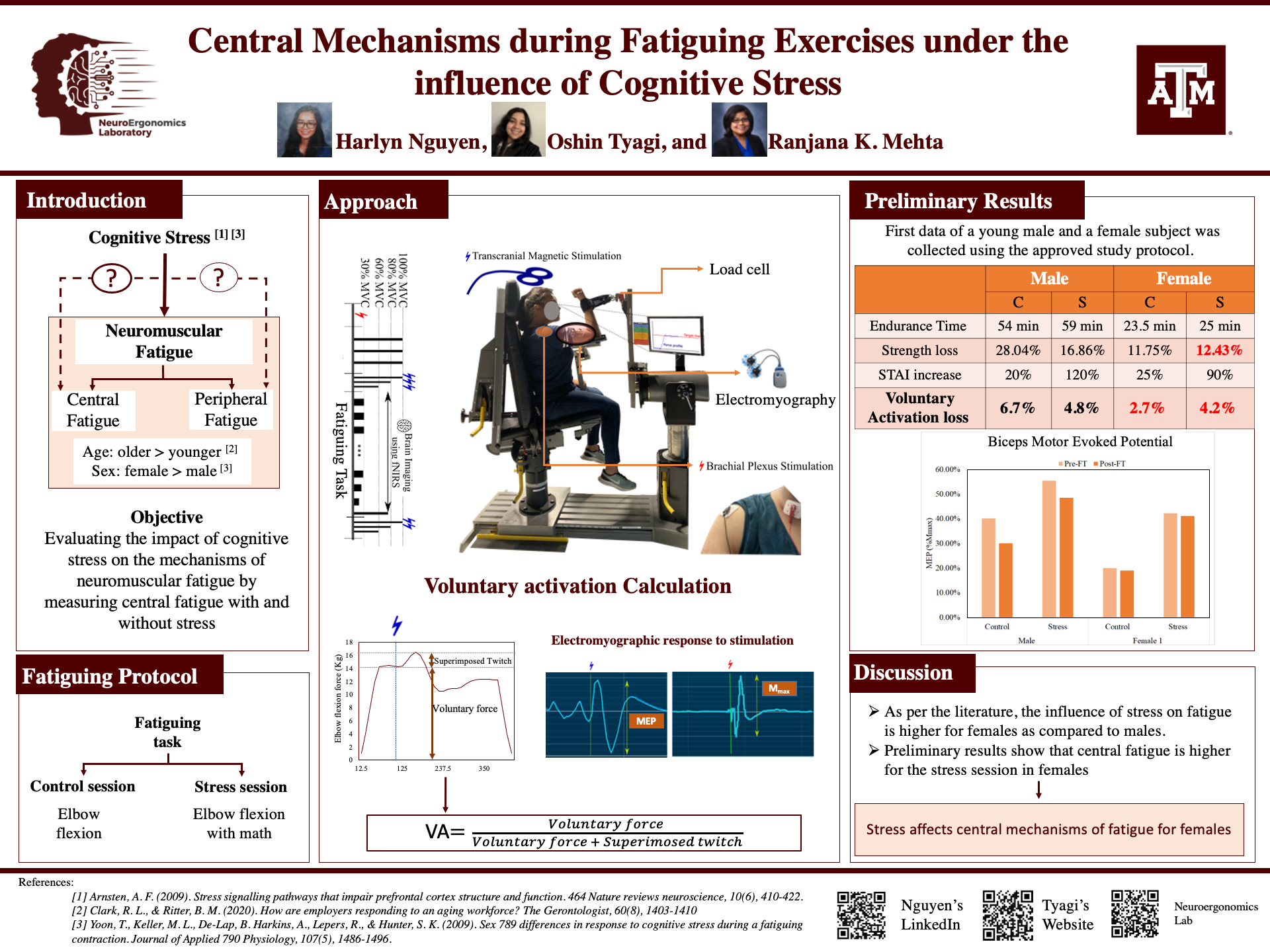
"Differential Effects of tDCS on Visuospatial Working Memory Performance under Fatigue"
Transcranial direct current stimulation (tDCS) of the left dorsolateral prefrontal cortex (dlPFC) has been shown to promote working memory (WM), however, its efficacy against cognitive fatigue-related performance declines remains uncertain. We report a subset of our observations from a larger study that examined the impact of anodal tDCS of the left DLPFC on visuospatial WM under cognitive fatigue. Specifically, we highlight the differential impact of tDCS on individual WM performance contingent on their baseline WM capacity.
We employed a repeated-measures design, with participants returning on separate days to perform a WM test under control, anodal tDCS, and sham tDCS. 32 participants completed the study (16 female). The participants were cast into three sex-balanced groups to counterbalance learning between conditions. In each session, participants completed a 60-minute visuospatial two-back test, divided into 12 five-minute blocks, with participants responding to subjective questionnaires between each block.
In these experiments, stimulation was provided during the sham and anodal tDCS conditions. A 1×1 tDCS device (Soterix Medical, NY, USA) was used with a cathode over the right supraorbital region (FP2) and the anode over the left dlPFC (F3) in accordance with the 10-10 EEG system. The current intensity was set at 1 mA, and the current density was 0.028 A/m2 (area = 5×7 cm2). Under anodal tDCS, the stimulation duration was 10 minutes at set point (1 mA); under sham tDCS, there was a ramp to setpoint followed by a ramp to 0 mA, lasting a total duration of 20s. The stimulation onset time was the same for both conditions, i.e., at the start of the fifth block (Karthikeyan &Mehta, 2020).
We found that both ‘HIGH’ performers and ‘LOW’ performers were tangibly aided by anodal tDCS. These improvements were seen to last beyond the stimulation interval for both groups, however, the magnitude change in accuracy was greater for ‘LOW’ performers. It is likely that the differences we note are associated with the effect of participant learning enhanced under anodal tDCS, in addition to region-wide cortical excitability and plasticity changes enabled via stimulation (Hill, Fitzgerald, & Hoy,
2016). Furthermore, the ‘HIGH’ performers were able to maintain their performance levels for longer than the ‘LOW’ performers, despite increasing perceptions of fatigue in both groups.
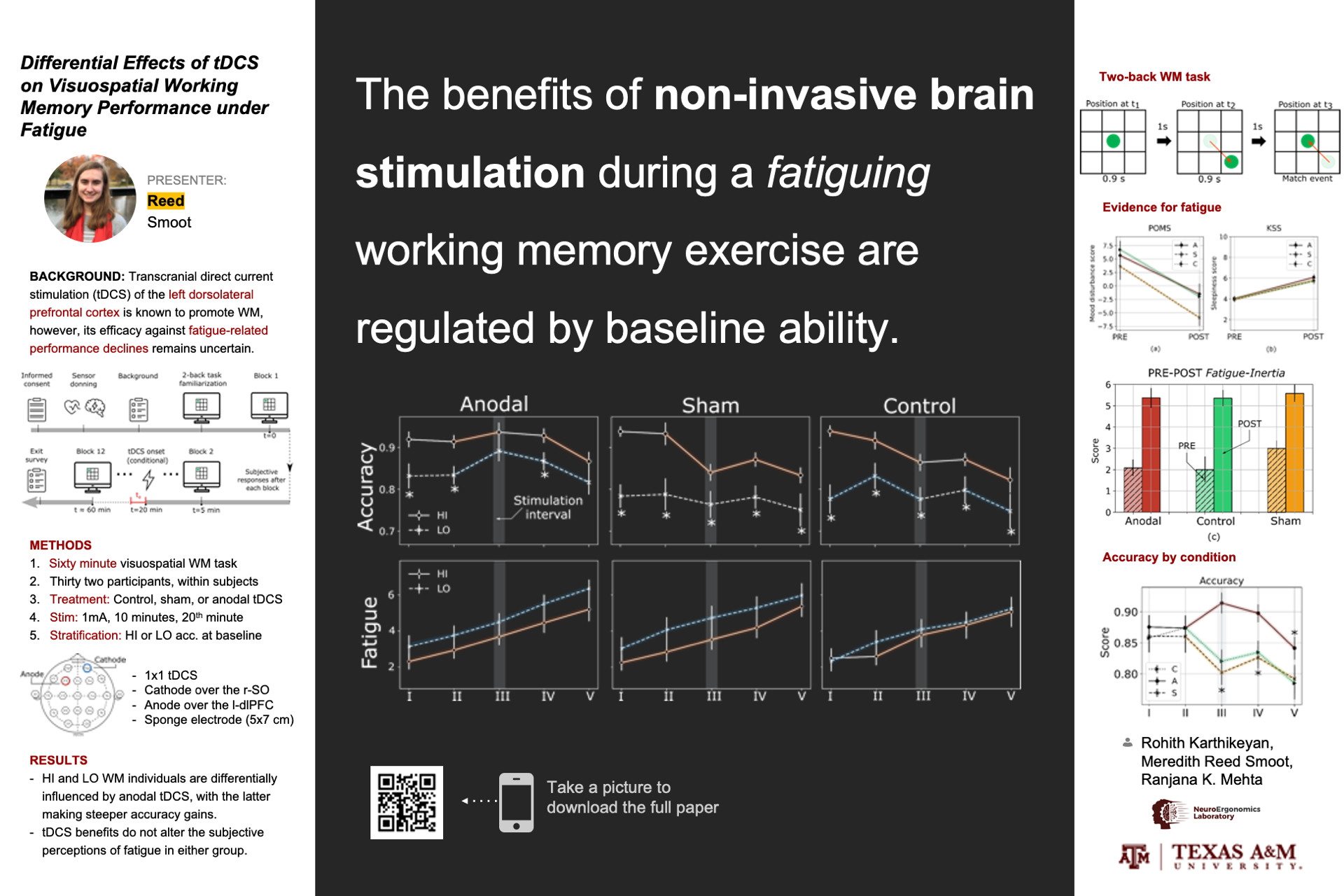
"Neural Signatures of Trust in Human-Robot Collaboration: A Tale of Two Use-Cases"
Trust in robotics is essential to its safe and effective utilization. We conducted two human-robot collaboration (HRC) studies to elicit the neurocognitive consequences of trust in robotics. Study one involved HRC for a metal surface polishing task, while study two used a gear planetary gear assembly task – these tasks differed in the human-robot interaction modes (teleoperated vs. collaborative). We manipulated robot reliability, performed brain imaging using fNIRS, and collected physiological heart rate data and subjective measures. Our analysis showed that neural signatures of trust are task-dependent, i.e., the brain responds differently to trusting and distrusting situations across the two HRC use-cases, while perceptions of trust or physiological responses did not provide such discrimination. The insights gained here can help carve newer neural metrics of trust in HRC that are informative of neurocognitive processes of downstream human behaviors.
